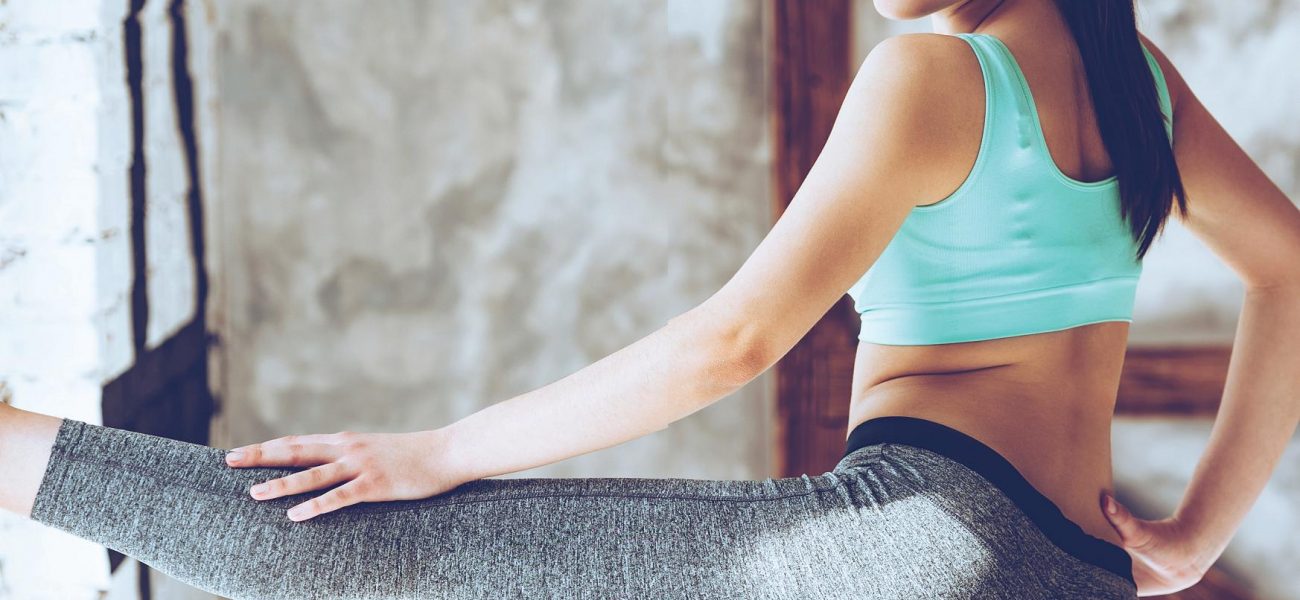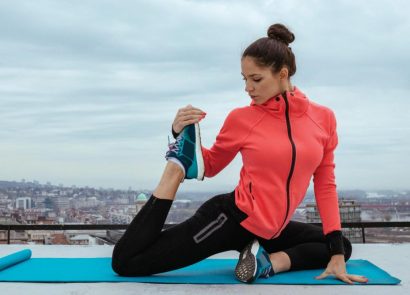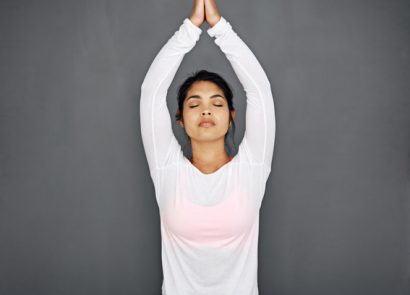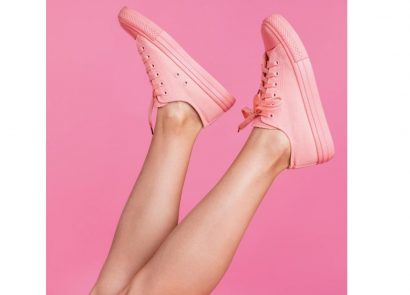
-
Hip flexors
“Runners and cyclists are particularly prone to tight hip flexors, as are those who spend most of their day at a desk. This is due to the way in which the hip joint flexes forward whilst these activities are carried out,” says Barrecore instructor Natasha Wynn. The problem with stiff hips is that they can create tension in the surrounding muscles such as the glutes and hamstrings, leading to difficulty when it comes to getting low in squats and lunges. Outside of the gym you can also suffer from poor posture and lower back pain. See things right with this simple stretch…
Step forward with the left leg as your right knee comes all the way to the ground. Flatten your right foot out so the toes are pointing behind you. Placing your hands on your sides, gently push your hips slightly forward. You will feel the stretch in your right hip flexor. Switch sides and repeat.

-
Shoulders
It’s easy to focus solely on the larger muscle groups like the abs, glutes and legs – these are the muscles we fire up during our workouts after all – but your poor little shoulders are doing way more than you think and failure to stretch them out can seriously impede your fitness efforts. “Those who lack flexibility in their shoulders may experience difficulty raising their arms directly overhead. This limited range of motion typically results in the reduced efficacy of arm and upper body exercises,” warns Natasha. If you’re feeling tight up top, try this simple stretch to work things out…
Kneel down in front of a wall and extend your arms overhead so that your palms are flat against the wall. Allow gravity to pull your chest toward the floor. If you’re not feeling it, inch your knees further away from the wall.
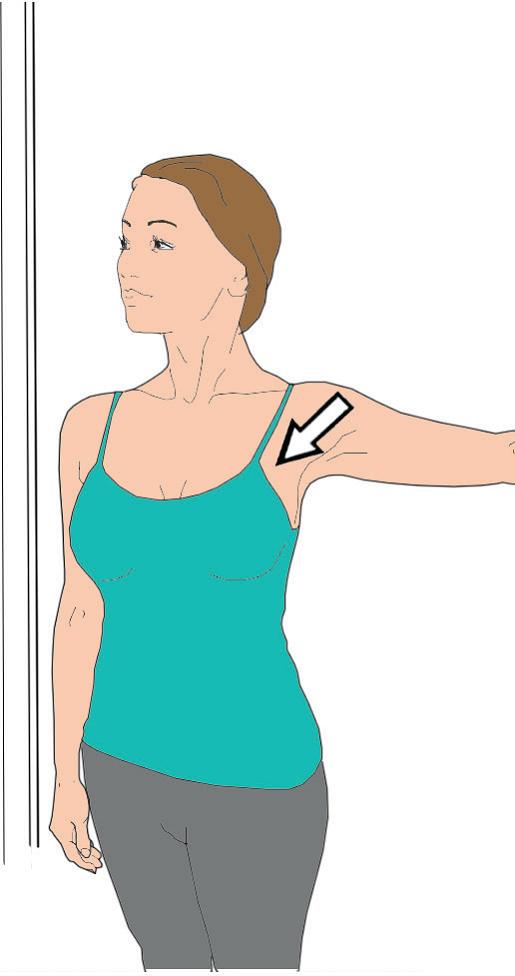
-
Glutes
“Your gluteal muscles need stretching in order to encourage good alignment for the whole leg. It’s not uncommon to find that knee pain and knee alignment issues actually stem from tightness in the this area,” says Natasha. But even if you’re not in any immediate pain, you should still aim to loosen up this muscle group. “In the gym, you need flexibility in the glutes to achieve a full squat position – that’s why stretching is just as important as strength work when training,” explains Natasha. So while tight glutes won’t limit too many day-today activities, it’s important to keep them limber in order to get the most out of your gym sessions.
Lie on your back with your legs flat on the ground. Bring your right knee towards your chest and hold in place with your hands to feel the stretch in the right buttock. Repeat the stretch with your opposite keg.

-
Hamstrings
Can’t touch your toes? Blame it on your day job! Sitting at a desk for eight hours a day causes your hamstrings to tighten for a prolonged period of time. If this isn’t balanced with regular stretching you will find that the backs of your thighs become stiff. The most obvious effect of this is an inability to bend fully forward at the waist, but the side effects don’t stop there. Tight hamstrings increase your risk of injury significantly, especially when it comes to activities such as running, high hurdling and acrobatics. Loosen things up with our favourite hammy move…
Lie on your back with your legs fully extended. Place a resistance band or scarf around your right food and use it to pull your leg up, ensuring that you don’t bend your knee. Repeat the stretch on your opposite leg.

-
Lower back
“Tightness and compression in the lower back can be pretty debilitating both in flexion (forward fold) and extension (back bend), and everything from crossfit to yoga can be affected by it,” explains Natasha. “Workouts that are high in impact, such as HIIT or running for example, involve impact on the joints that reverberates all the way from the feet up into the spine. On the other hand, exercises such as yoga that require fluidity of movement call for a strong yet supple back supported by strength in the abdominals.”
Kneel down with your bum on your heels and extende your arms in front of you as you lower your head towards the floor.

-
Calves
Believe it or not, the most common reason for tight calves is actually high heels. Sporting shoes higher than two inches forces you to walk on your tip toes. This shortens the distance between your ankles and your knees, causing the calf muscles to contract and tighten. If you’re donning your ruby red slippers on a one-off occasion, you’ve probably got nothing to worry about. But everyday wear can cause the muscle to freeze permanently in its contracted state, leading to discomfort when running and jumping on solid ground. Try this move after a day spent running around in heels…
Stand with your feet together at the foot of some stairs. Grab hold of a wall or railing and tilt your heels backwards to feel the stretch in your calves.
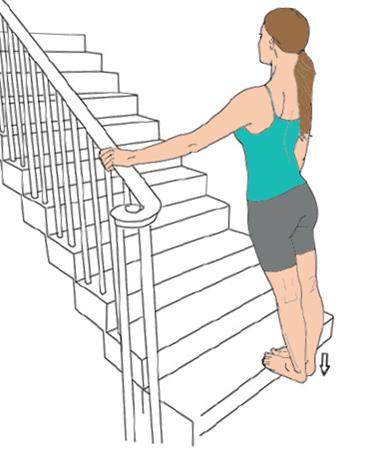
-
Quads
Stretching out your quadriceps is an absolute must after climbing, cycling, running, stair-stepping, or any other activity that targets your thighs. The quads are put under a lot of strain in workouts and they can easily seize up if they’re not given the proper aftercare. As with the glutes, tight thighs can also lead to knee and back pain, but this easy stretch done properly will soon see you right.
Whilst standing, hold the top of your foot with your opposite hand and gently pull your heel towards your bum. Can’t feel it? Thrust your pelvis slightly forward to intensify the stretch










